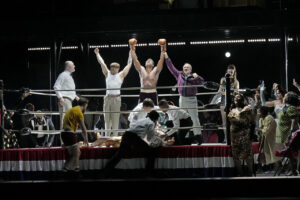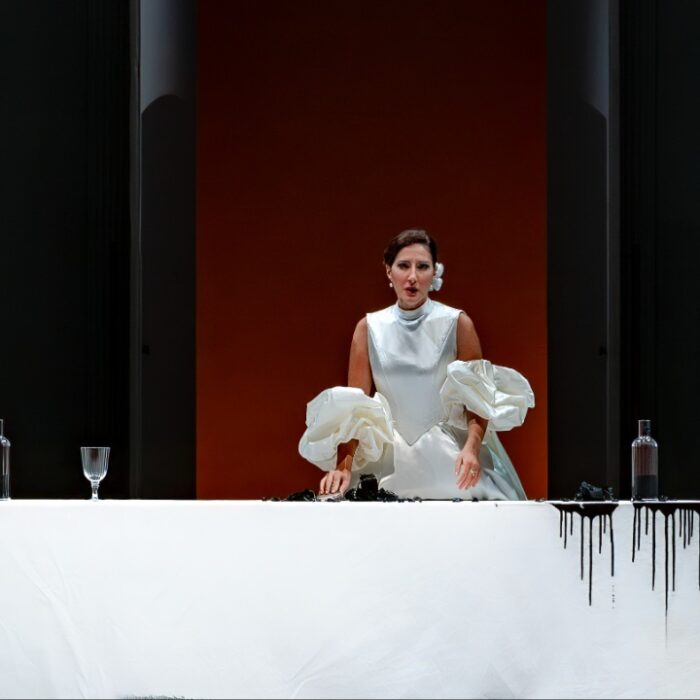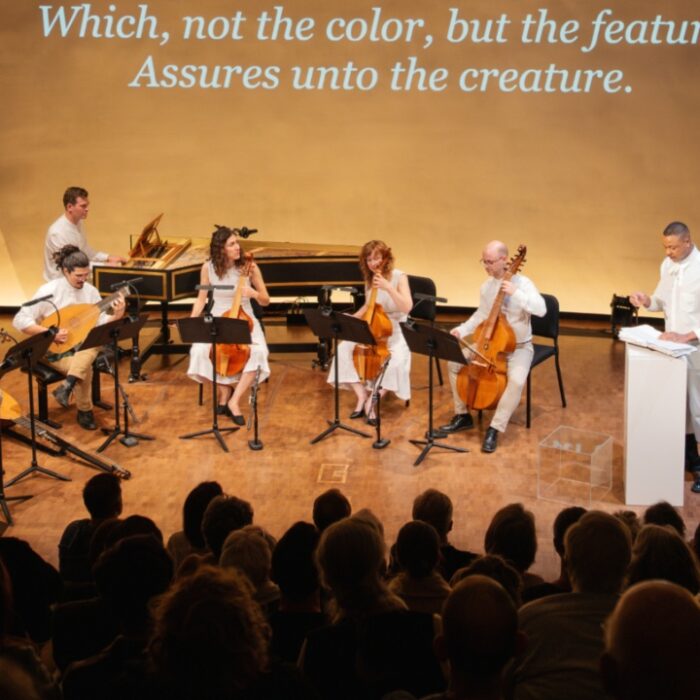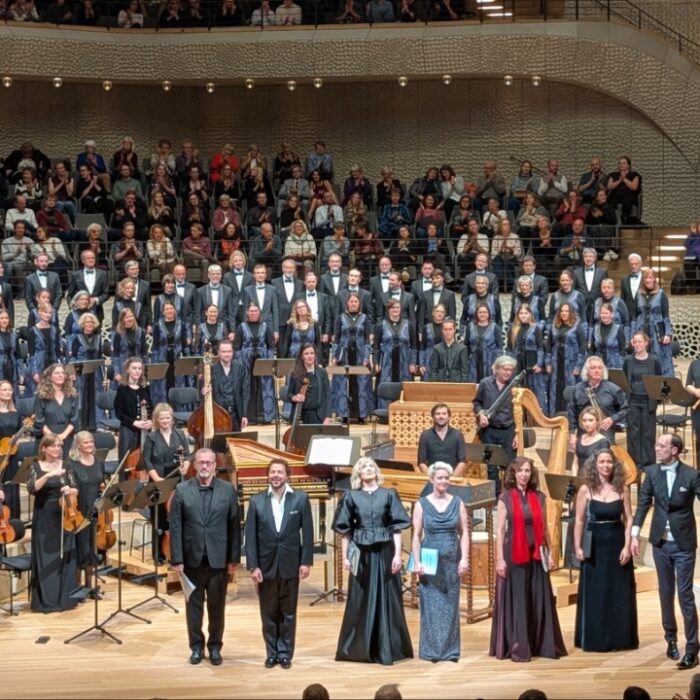
Metropolitan Opera 2022-23 Review: Champion
Terence Blanchard’s First Opera is A Work in Search of its Identity
By David SalazarTerence Blanchard and Michael Cristofer’s “Champion” made its Met Opera premiere on April 10, 2023 to a nearly sold-out crowd. Just entering the main lobby, you were met with a 10-minute line to pick up tickets. But most importantly, you could feel the buzz in the space, a massive, diverse audience, ready to take in what is undeniably a major cultural event, especially in light of the great success from last year’s masterful “Fire Shut Up in My Bones,” Blanchard’s second opera, which opened the Met Opera’s 2021-22 season.
Entering the great hall, the viewer was immediately seized by the large black-and-white image of a boxer in combat, setting the stage for an intense evening.
But instead of landing a knockout punch, the experience of “Champion” was more of a solid fight without a clear winner. Ultimately, it is an opera in search of its identity, which works in favor of the opera thematically, but also against its grander form and corresponding function.
Exploring Emile Griffith
The opera explores the real-life story of famed boxer Emile Griffith, his struggles with identity, and the tragic match that changed his life. As structured by Blanchard and Cristofer, the opera opens with old Emile Griffith struggling with dementia in an apartment on Long Island. From there he flashes back and forth between past and present, remembering the events that would shape his life. We see him leave his home in Saint Thomas, reunite with his estranged mother in New York, reluctantly take on his boxing career, and then have to contend with his homosexuality in a world where being gay was seen as being a disease.
This all climaxes in the first half of the opera when Emile takes on Benny “Kid” Paret in the ring; at one point Benny taunts Emile with homophobic slurs and in the ring, Emile responds by putting Benny in a coma that ultimately leads to his death. The second half of the opera is a reckoning of sorts for Emile, who must come to terms with what it feels like to “kill someone,” confronting him with the isolation that comes with his identity and the loss he has experienced.
In the opera’s most heartbreaking moment, Emile tells Luis, his caretaker in his older age, “I kill a man and the world forgives me. I love a man and the world wants to kill me.”
As with his operatic masterpiece “Fire Shut Up in My Bones,” Blanchard’s flashback structure allows him to present Emile in various guises, both as an old man (Eric Owens), a young man (Ryan Speedo Green), and even as a child (Ethan Joseph). Much like we see in “Fire Shut Up in My Bones,” this literal fracturing of the self on stage plays into the protagonist’s struggles with identity; the stream of consciousness structure, especially in the context of Emile’s dementia, furthers this thematic relationship and gives the narrative’s flow and propulsive manner rhyme and reason.
Repetition plays a vital part in this opera’s dramatic and musical language, to mixed effect. The opera opens with Emile contemplating his missing shoe and struggling with understanding his place in all things. This obsession with objects and their placement will continue throughout the first half with hats taking on a major prominence, and the shoe motif coming back again and again. While philosophically, this metaphor has strong emotional resonance, especially when considering that Emile, as a gay man struggles with finding a place in the world, whereas simple objects like shoes and hats are more clearly defined, the constant regurgitation of the motif starts to feel heavy-handed. The same goes for several lines of dialogue that while essential dramatic reminders, lose their power through diminished returns and eventually just feel a bit dismissive of the audience’s attention span and retention. There are some powerful moments with the use of repetition as a dramatic device, especially when reporters ask Emile how it feels to be champion during a montage sequence where his biggest victories are laid out for the audience. But after three repetitions of the same question, suddenly he gets asked how it feels to kill a man.
Another solid use of repetition as a dramatic and comic device comes when Emile meets his mother Emelda. She asks for a kiss and hugs from her son, thinking Emile is Franklin. When she realizes her mistake, she repeats the same music and text, but this time aimed at Emile. It has a comic effect that showcases the brilliant use of the dramatic device. But moments later, in a ponderous moment, Emelda ponders about her worth as a mother and the text gets repeated again and again without seemingly adding nuance or layers to her characterization (we have to wait until the second Act where she gets a potent aria in which these very themes are developed through music and text). Right after this mother-son scene, we get the introduction of Howie Albert, Emile’s eventual manager, and their meeting is laden with the same use of repetition as Emelda and Emile’s first encounter. While the repetition of both text and music has some added comic effect with the addition of the chorus for the second half, this section represents the opera’s challenges with flow both dramatically and musically.
This scene is where Emile’s destiny is sealed. Without him realizing it, he’s about to become a boxer against his will. Blanchard sets the scene with a fun jazz theme that just goes in circles, which fits in well with the text repeating itself. But it doesn’t develop as such and the ultimate moment, where Emile is goaded into punching Howie and thus sealing his fate doesn’t take the music anywhere new. Instead, it just stops, and we’re off. At its most crucial moment, the music has nothing to add.
And this is often the major musical issue with “Champion.” Blanchard seizes on a wide range of musical languages and genres and the resulting mélange lends itself well to this exploration of identity and lack of belonging. However, “Fire Shut in my Bones” did this as well. But what made that masterpiece work was that the music always felt like it was working alongside the text to explore the characters and elevate the story. It was an active narrator. In “Champion,” the music often feels passive and even detached from the text, often just background to set the mood while the text and production do the dramatic heavy lifting. A lot of the jazz pieces blur into one another, none quite musically distinct outside of the dramatic situation presented by the text. Take Emile’s scene at Kathy Hagen’s. This is the first scene where his identity as a gay man is introduced. And while we get one major shift in the scene where a Young Emile sings about having the devil inside, the remainder of the scene is rather casual musically, never allowing us any real insight into Emile’s own feelings or thoughts outside of what the text and, more prominently, the staging shows us.
To be fair, the opera’s propulsive and cinematic storytelling often lends itself to this kind of forward-moving musical flow, but some moments, such as when Emile insults every person in his life (thus guaranteeing his eventual loneliness), moves so quickly as to almost feel like an afterthought dramatically; again, the text and staging shape this moment more than the music does. What results is the feeling that we are often watching a play with incidental music rather than an opera where both come together to deliver a fully-fleshed music drama.
Where Blanchard has his biggest success is when the action slows down and lets the characters have moments of introspection. Here the music takes centerstage and is allowed more breadth of vocal line and instrumentation (or lack thereof), giving us some of the most powerful moments of the night. Among these is Emile’s aria “What makes a man a man?,” little Emile’s meditation on his long night, and more importantly, Emelda’s solo as she explains why she had to abandon her children to survive. This latter aria is notable for its use of a single double bass accompaniment set against the vocal line; it’s an endlessly magical passage. Ditto for the opera’s final chorus and the constant returns to the “shoe” monologue that opens and closes the opera. Each moment has a distinct character and presages what Blanchard would come to master in “Fire Shut Up in My Bones.”
What he also mastered in that second opera is vocal writing, which is undeniably the weakest part of “Champion’s” music. When one singer struggles the entire night, one can surmise that it’s on the singer. But when all these singers have their share of troubles throughout the night, then you start to wonder about how the opera was written. At some point or another every single soloist seemed to struggle with some of the higher notes, often squeezing their sounds to get them out. At others, they were completely drowned out with the low writing. At one point during the scene with Kathy Hagen, the writing for Emile was so low that Ryan Speedo Green’s vibrant bass-baritone sounded like a hollow growl that he was struggling to project. Earlier in the opera, Latonia Moore is asked to sing a rhythmic and fast-moving passage as we see Emile get ready for his boxing career. It’s a virtuosic and verbose passage. It’s also written in a lower part of Moore’s voice that, due to how it was written, made it impossible to understand most of the many words she was saying without the aid of the subtitles. Again, that’s not to say that the vocal writing doesn’t have some powerful moments – once again, those solo moments, particularly “What makes a man a man” and Emelda’s second act aria, are undeniably the winners.
Carrying the Dramatic & Emotional Weight
Much as they did with “Fire Shut Up in My Bones,” and perhaps even moreso this time given the opera’s over-reliance on the production for dramatic clarity, director James Robinson and Camile A. Brown bring “Champion” to life with a mesmerizing production. The production features a series of massive screens around the stage with the central area reserved for shifting sets. The projections are constantly in flux, allowing for the opera to take on a cinematic flow, especially with the scenes changing constantly early on. The many montages of Emile’s rise and fall are correspondingly expressed through these projections as well.
But perhaps the most potent visuals come from the climactic fight between Emile and Benny where each punch on stage is correspondingly showcased in cinematic form on the projections. The coordination between stage and screen in this particular case was nothing short of perfection and a textbook reference for other opera productions that want to employ a similar marriage without one detracting from the other. During “When’s a man a man,” the stage goes bare with blue light to allow Emile the central spotlight. However, the projections showcase him glaring into a mirror, trying to find himself; another perfect communion between stage and screen.
Brown’s choreography doesn’t quite get the touchstone moment that it got in “Fire Shut Up in My Bones” with the Kappa Alpha Psi scene, but Chris Dumont’s choreography for the fight scenes really stands out, especially the boxing scenes and, most prominently, when Emile gets beat up in the streets and the opera links past to present by swapping one Emile for another seamlessly.
Creating Emile
In the title role of Emile, audiences got to see a knockout duo of Eric Owens and Ryan Speedo Green. The two could not have been more different and yet complimentary to one another, enhancing this feeling of Emile’s fracture psyche. Eric Owens opened the opera, his granular yet soft bass showcased in Blanchard’s searching lines, emphasizing older Emile’s longing. He moved about with a short and slow gait, emphasizing this feeling of a man lost in time and space, and his appearances throughout the early portions of the opera (and then later interjections), only added to this feeling.
Contrasting that was Speedo Green, who sang with a much silkier and robust sound, which was often tested throughout by a wide variety of vocal styles, especially more rhythmic dance numbers during the start of both halves of the opera. His “When’s a man a man” was a highlight of his vocal interpretation, his legato allowed to flourish, imbuing the younger Emile with a touch of what he would eventually become in Owens’ incarnation. When the two got moments to sing together, they blended their instruments so well together that they literally sounded like one. Adding to this character development were the physical demands of the role. From his first entrance in Saint Thomas, Speedo Green was asked to sing and dance at the same time and he did so with tremendous confidence. Later on, he would have to engage in training montages (a number of pushups) and other boxing-related moments that furthered the gap between this Emile and the one that we see at the end of the opera, barely able to move.
And to add to this, the opera gave us the gift of Ethan Joseph as the youngest incarnation of the character. He gets one of the touchstone moments of the opera when young Emile, while at Kathy Hagen’s remembers being beaten as a child. While holding a cinderblock the child Emile remarks on how he has the devil inside. The passage has a treacherous vocal line that often starts each phrase at its highest point. Throw in the thin orchestration and the singer is as exposed as can be. But Joseph dispatched the passage with not only confidence, but with a gentle and smooth vocal line that earned him, deservedly, one of the biggest ovations of the night.
Latonia Moore was the star of “Fire Shut Up in My Bones,” and here she steals her moments as Emelda Griffith, Emile’s mother. She showcases a very playful nature from the off, and her voice embraced this character throughout, particularly in her first interactions with her son and then as she convinced Howie Albert to hire him. But her character’s seeming vapidity eventually gave way to a more tragic nature as she sang her final aria, her voice ferocious in its intensity as she laid bare her need to survive amidst the pain she might have caused.
Paul Groves took on the role of Howie Albert and struggled vocally throughout the night. Any attempt to go into his upper range resulted in pinched high notes and he often seemed overpowered by the orchestra. At one point, prior to his fight with Benny, he is coaching Emile to keep his mouth shut. The music rises and rises, seemingly emphasizing Howie’s prominence and control in this scene; however, Groves never quite rose to those same levels and his voice was completely drowned out at the height of the phrase. Later on, he gets his own solo moment as he questions why Benny was allowed to fight and why no one is questioning that instead of bullying Emile for the result. While he managed the passage, he did so uncomfortably, his voice sounding most comfortable when he had to speak the text rather than sing it.
Stephanie Blythe got to show off the elegance of her jazz singing as Kathy Hagen. While some attempts to fill out her higher range did often go awry, there was no doubt that she was having a blast taking up space both on stage and vocally in the hall.
Chauncey Packer was gentle and loving throughout as Luis, while Eric Greene, in his Met debut, showcased the generational divide as both Benny and his son Benny Jr; as the former, he displayed a harsh and rugged bass-baritone, while imbuing his sound with more grace and elegance as his son. Krysty Swann’s mezzo had an appropriately rough edge to it as Cousin Blanche, the woman who beats young Emile, while Brittany Renee, as Emile’s wife Saide Donastorg, had a silky sensuality in her brief meeting with her husband-to-be. Edward Nelson, also in his Met debut, displayed a sturdy baritone as he flirted with Emile at a bar near the end of the opera, while Lee Wilkof provided some well-timed comedy as the Ring Announcer throughout the performance.
In the pit, Yannick Nézet-Séguin once again proved why he’s one of the best at taking on newer works. At this point, it feels, especially, given his inconsistent form with repertory staples, that this should be his main task at the Met. The orchestra sounded steady throughout and you could tell he had a solid grasp on the balance required between pit and stage. One standout moment for me was Little Emile’s solo, a treacherous passage for Ethan Joseph that came off beautifully not only because of the young boy’s incredible talents, but because the maestro was with him every step of the way.
All in all, “Champion,” while not providing a consistent musical experience, certainly packs an emotional and visual punch.


